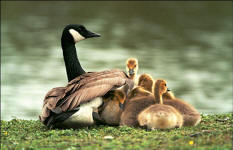Ducks and Geese
Rescue and stabilizing ducklings/goslings
| Pick up the duckling/gosling using your hands if possible. If it cannot safely be caught with your hands, gently place a clean, lightweight cloth over it, and catch it while it's covered. Prepare a container, such as a pet carrier or a deep cardboard box (ducklings can jump two-feet high) with a heat source and some soft, absorbent material, such as paper towels or newspaper, or clean cloths. | |
The younger the duckling/gosling, the more important it is to keep him warm. Ducklings/goslings should not be kept in water. Ducklings/goslings need an external source of heat such as a heating pad set on low or a hot water bottle filled with warm (not hot) water. A temporary, disposable heating pad can be made by putting some dry rice or beans in a sock and knot close, and microwave it for one minute. Cover the bag with cloth or several layers of paper and nestle the duckling/goslings into the softness.
|
|
 |
Watching
the antics of wild, healthy ducks and geese is a pleasure in our
neighborhoods, parks and places of business, but what happens when an ill or
injured duck or goose or abandoned duckling/gosling is found? The
proliferation of man-made lakes in the greater Phoenix area, while providing
cooling beauty, has resulted in soaring populations of domestic and
migratory ducks and geese. Since ducks and geese are here because man created water places, conscience dictates that we assist them when things go wrong. Ducks and geese are frequently injured by fishing line, hooks, lead weights, litter, blow darts, arrows, chemicals, cars, and pets. None of these are natural occurrences, and prevention is the best policy. But if you find an ill or injured duck or goose, call a rehabber. |
Click here to go to the Ducks and Geese Photo Gallery
To find an East Valley Wildlife rehabilitator call 480-814-9339 or ![]() .
.
Ducklings
Hatching is a stressful ordeal for a new little duckling or gosling,
and time is needed afterwards to dry off and regain strength.
Sometimes, by the time the last ducklings/goslings hatch their older
siblings are active and anxious to find water. Here are some points
to remember: Ducklings or
goslings that hatch last may not have enough time to recover; they
may not keep up with the family and eventually fall behind.
Sometimes ducklings/goslings stray from the group and get lost. A mother duck or
goose may also abandon eggs that are slow to hatch, concentrating
instead on getting active ducklings/goslings to food, water, and
safety. If abandoned eggs hatch after she leaves the nest, the
ducklings/goslings are left to fend for themselves. If you're able to
catch a lone, dry duckling or gosling, with duck/goose families
nearby, walk around the area, including the shores of lakes or
streams with the duckling or gosling cupped securely in your hands.
Let it peep loudly. Only it's mother will respond to it's cries, and
she should respond in a frantic, angry manner. Never put
lost ducklings or goslings back into the water unless you're
confident you've located it's particular family; it is not likely to
survive without it's mother, and another mother duck or goose If
you find a wet duckling or gosling, or find an abandoned
duckling/gosling with no duck/goose families in the area, it is not
likely to survive on its own and it must be rescued.
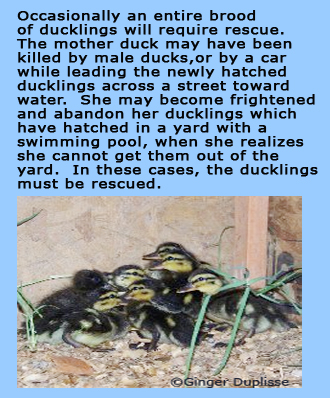
will reject it.
Do not
keep the youngster in water. It must be kept warm with a heat source such as a heating pad or hot water bottle. Ducklings and goslings do not have the waterproofing adults of their
species has.

East Valley Wildlife also handles domestic ducks and geese on community lakes. We do not, however, have room to take in unwanted pets. Putting ads in feed stores or placing an ad in the newspaper is advisable if you have a pet duck or goose that you no longer want.
Ducklings in your swimming pool?

Ducklings/Goslings in a yard, office park or parking lot
|
|
When a mother hatches her ducklings/goslings in a yard, office complex, or parking lot, she may have no way to get them safely to water. If the property is near a lake or stream and you can open a gate so the mother can safely lead her brood to water, this is ideal. |
| If there are no pets or traffic nearby, you may allow the mother to raise the ducklings there until they are old enough to fly away. You will need to buy or borrow a wading pool, provide correct shelter and nutrition for the little family, and put up with a considerable mess for several weeks. For instructions and support, call a waterfowl rehabber. | |
If
the family is in or near a swimming pool:
|
|
Article: WHAT TO DO WHEN YOU FIND AN ORPHANED DUCKLING NEAR A LAKE
Wing Injury
 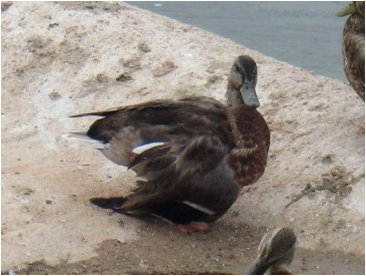 |
|
Male mallard with broken wing. Eclipse feathering (the males lose their mating feathers during the summer and change to look more like females) This male is in the process of losing the green head and will soon have mottled brown feathers until the fall. Call a rehabber if you find a duck with a broken wing. |
|
Angel Wing
 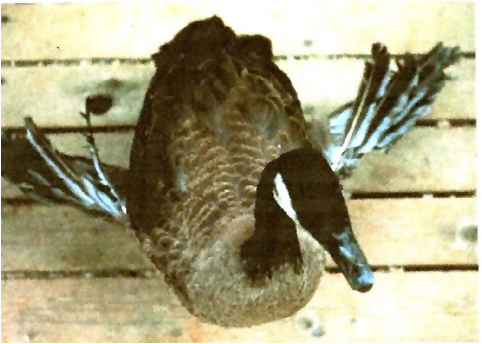 |
The disease manifests as an incurable anatomical condition which is acquired in young birds. Due to a high-calorie diet, especially one high in proteins and/or low in vitamin D, vitamin E and manganese, one or both carpus (wrist) joints are retarded in their development relative to the rest of the wing; for reasons unknown, if only one wing is affected it is usually the left one. The result is a wrist which is twisted outwards and unable to perform its usual function. Angel wing symptoms include stripped remiges (flight feathers) in the wrist area, or remiges protruding from wings at odd angles. In extreme cases, the stripped feathers may resemble sickly blue straw protruding from wings. In adult birds the disease is incurable and usually leads to an early death as affected birds are rendered effectively or totally flightless. In young birds wrapping the wing and binding it against the bird's flank, together with feeding the bird a more natural diet, can reverse the damage. The only wild waterfowl populations known to be affected are those fed by man. |
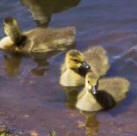 |
Reality Check It is inadvisable to try to raise a lone duckling. He needs the company of other ducklings and the expertise of trained rehabbers in order to grow up healthy and wild as nature intended. |
 |
Did You Know? A female duck lays one egg a day (4 to 24 eggs) and cleverly waits to sit on them until after she has finished laying. This way all the eggs will be incubated at the same time and hatch within a 24 hour period. |
|
| FOSTER PROGRAM EVW is in need of committed people interested in adopting or fostering ducks, geese and ducklings. Criteria for adopting are: - Secure Fencing - Shade & Shelter - Water Area - Food Supply - Safety from Predators Contact Nancy at: EVWildlife. if you are interested. |
 |
LITTER KILLS A large number of waterfowl rescues and sometimes death is a result of fishing hooks and fishing line litter. The waterfowl get tangled in the line causing injury to feet, wings etc or get hooks in their eyes or mouth making it impossible to eat. Eventually infection or starvation will overcome them. Please teach your children and remind the adults not to leave their tackle after they have gone. |

